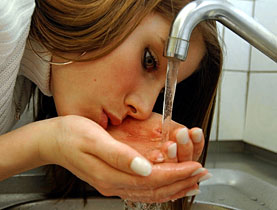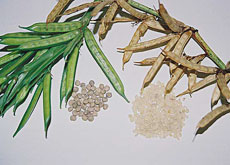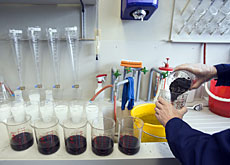High Swiss lead levels spark concern

Levels of lead in the blood of the Swiss population are higher than in comparable European countries and the United States.
The reasons for the Swiss anomaly are unknown, according to the Federal Health Office, which says it is still below the risk threshold.
Elevated blood lead level – defined as ten milligrams per deciliter (µg/dL) or above – is of particular concern for children. It has been associated with toxicity in the developing brain and nervous system of young children, leading to lower IQ.
The average blood lead rate in Switzerland is seven µg/dL, while neighbouring countries and the US have rates of below five µg/dL. Recent studies have raised doubt over the recommended limit, showing loss of IQ in children under that level.
A 2007 report on lead by the European Environment and Health Information System, under the auspices of the World Health Organization, called for more prevention activities: “It is still necessary to reduce the levels of lead in the blood further because there is no known safe level in children.”
Research published by the University of Cincinnati in the US last month took the case against lead a step further. It claimed that exposure to excess lead in early childhood or in the womb could cause not just permanent brain damage but also criminal behaviour.
Safer petrol
Vincent Dudler, head of the Chemical Risk section of the Federal Health Office, told swissinfo that new tests to monitor Swiss blood lead levels would be completed in 2009.
“We want to monitor the population again to see if the level is stable or decreasing,” he said.
However, current levels of lead exposure are far lower than those experienced in the 1970s, when monitoring began in Switzerland. The phasing out of leaded petrol was a major factor contributing to this decrease.
The other main culprit in lead contamination is lead paint. Young children are at particular risk of ingesting dust or paint chips from lead paint in old buildings.
“If you have old paint and small children in the house, I would suggest repainting the rooms,” Dudler advised. Paint stripping should be done by professionals to avoid increased lead exposure.
Drinking water
Dudler also highlighted the risk of exposure to lead in drinking water. “The fittings in the plumbing system are all metallic and these type of metals always contain a little lead… You have continuous leaching of lead into the water, even in new houses.”
“Maybe the reason for the difference between the US and Switzerland is that in Switzerland people are used to drinking water from the tap and exposure is higher, but that’s only my hypothesis,” he added.
A simple way to reduce the concentration of lead in tap water is to let the water run for a minute at the start of the day to flush out the water sitting in the pipes.
Dudler also warned against using poor quality glazed ceramics, which may not have been sufficiently fired, to serve food or drink.
“If people are in any doubt about the quality of their ceramics they can bring them to the cantonal laboratory to be tested for a nominal sum,” he said.
The Swiss Toxicological Information Centre (STIC) provides expertise and a helpline for toxicological emergencies. A spokesman told swissinfo that the few cases of lead poisoning they encountered were usually work related.
“The unspecific symptoms associated with exposure to low doses of lead are unlikely to bring people to our attention,” he said.
The WHO is in the process of reviewing and updating the latest information available on lead exposure in children and preparing new guidance and information materials for the health sector.
Lead is a toxic metal known to be harmful to human health if inhaled or ingested.
Controls on lead in petrol have significantly reduced people’s exposure to lead.
The degree of harm depends upon the level of exposure from all sources.
Prolonged exposure induces lead accumulation in the body and may cause adverse effects on the central nervous system, on the heart and kidneys and on the blood and reproductive systems.
The type and severity of health effects depend on the level, duration and timing of exposure, as well as the age of the person exposed.
The most frequent test to measure lead in the human body is the blood lead level, with a safety threshold of ten milligrams per decilitre set by the WHO in 1995.
The main sources of lead exposure are:
Air, soil and dust, both inside and outside the home;
Food – which can be contaminated by lead in the air or in food containers;
Water, from the corrosion of plumbing.

In compliance with the JTI standards
More: SWI swissinfo.ch certified by the Journalism Trust Initiative











You can find an overview of ongoing debates with our journalists here . Please join us!
If you want to start a conversation about a topic raised in this article or want to report factual errors, email us at english@swissinfo.ch.